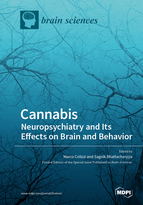Cannabis: Neuropsychiatry and Its Effects on Brain and Behavior
A special issue of Brain Sciences (ISSN 2076-3425). This special issue belongs to the section "Systems Neuroscience".
Deadline for manuscript submissions: closed (15 May 2020) | Viewed by 71139
Special Issue Editors
Interests: psychosis; neuropsychopharmacology; brain imaging; cannabinoids; cognitive neuroscience
Special Issues, Collections and Topics in MDPI journals
Special Issue Information
Dear Colleagues,
Over the years, there has been increasing interest into the public health impact of cannabis use, especially by young adults. This follows the evidence of a growing prevalence of regular cannabis use worldwide, with approximately 200 million users. Recreational cannabis use, especially a frequent use of products with high levels of its main psychoactive ingredient delta-9-tetrahydrocannabinol (Δ 9-THC), can cause dependence and have transient and long-lasting detrimental mental health effects, also negatively impacting cognitive processing and brain function and metabolism. In regular users, the development of tolerance to some of the effects of cannabis, especially the pleasurable ones, may lead to progressively heavier use in order to obtain the same effects in terms of their intensity, with higher health risks. However, the Cannabis Sativa plant contains different chemicals with different potential effects. In this regard, cannabidiol has gained interest because of its potential therapeutic properties, in line with evidence that CBD and Δ9-THC may exhibit opposite effects at the cannabinoid receptor type 1 (CB1), Δ9-THC being a partial agonist and CBD an antagonist/inverse agonist.
Different cannabinoids may modulate human brain function and behavior in different ways, with different risk–benefit profiles. Original research articles advancing our understanding of the “Neuropsychiatry and Brain effects of Cannabis” are solicited for this Special Issue. Reviews providing an analytical perspective on the existing literature are also welcome.
Dr. Marco Colizzi
Dr. Sagnik Bhattacharyya
Guest Editors
Manuscript Submission Information
Manuscripts should be submitted online at www.mdpi.com by registering and logging in to this website. Once you are registered, click here to go to the submission form. Manuscripts can be submitted until the deadline. All submissions that pass pre-check are peer-reviewed. Accepted papers will be published continuously in the journal (as soon as accepted) and will be listed together on the special issue website. Research articles, review articles as well as short communications are invited. For planned papers, a title and short abstract (about 100 words) can be sent to the Editorial Office for announcement on this website.
Submitted manuscripts should not have been published previously, nor be under consideration for publication elsewhere (except conference proceedings papers). All manuscripts are thoroughly refereed through a single-blind peer-review process. A guide for authors and other relevant information for submission of manuscripts is available on the Instructions for Authors page. Brain Sciences is an international peer-reviewed open access monthly journal published by MDPI.
Please visit the Instructions for Authors page before submitting a manuscript. The Article Processing Charge (APC) for publication in this open access journal is 2200 CHF (Swiss Francs). Submitted papers should be well formatted and use good English. Authors may use MDPI's English editing service prior to publication or during author revisions.
Keywords
- Cannabinoids
- Delta-9-tetrahydrocannabinol
- Cannabidiol
- Cannabis use disorders
- Dependence
- Tolerance
- Neuropsychiatric disorders
- Cognition
- Neurophysiology
- Neurochemistry








